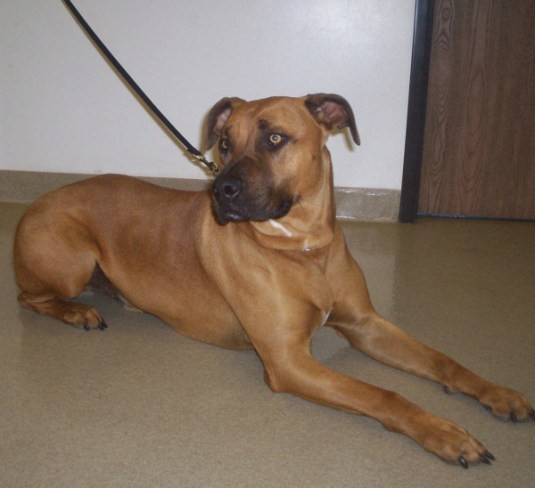
The Pitbull Rhodesian Ridgeback mix represents a fascinating hybrid that combines the strength and loyalty of two remarkable breeds. This crossbreed inherits the muscular build and protective instincts of the Rhodesian Ridgeback with the affectionate nature and intelligence of the Pitbull. Standing 24-27 inches tall and weighing between 70-85 pounds, these dogs possess a unique blend of physical and behavioral traits. While often misunderstood due to stereotypes associated with both parent breeds, these dogs are known for their unwavering loyalty, high energy levels, and potential to be excellent family companions when properly trained and socialized.
Pitbull and Rhodesian Ridgeback Mix
Exercise Requirements and Energy Management
Recent studies show that Ridgeback Pitbull mixes require 1-2 hours of daily exercise split into multiple sessions. This high energy level stems from both parent breeds' athletic nature. Beyond basic physical activity, these dogs benefit from:
- Agility training to challenge both mind and body
- Interactive play sessions with puzzle toys
- Structured exercise routines with clear start/end times
- Designated rest periods between activities
Socialization and Training Approach
Expert guidance emphasizes that successful training requires:
- Consistent positive reinforcement methods
- Early exposure to various environments and situations
- Clear boundaries and rules from day one
- Professional training support for first-time owners
The breed's intelligence combined with an independent streak means owners must establish themselves as confident leaders while maintaining patience during training sessions. Training specialists recommend starting socialization as early as 8 weeks old, with controlled introductions to:
- Different age groups of people
- Various environmental sounds
- Multiple surface textures
- Other animals in supervised settings
This methodical approach helps prevent the development of anxiety or aggressive tendencies that can emerge without proper socialization.
Overview of the Rhodesian Ridgeback Pitbull Mix
Physical Characteristics and Breed Standards
The Rhodesian Ridgeback Pitbull mix typically stands 24-27 inches tall and weighs between 70-85 pounds, with males being slightly larger than females. Their coat is short and comes in various colors including white, black, brown, red, and gold. These dogs inherit a strong, muscular build from both parent breeds, featuring:
- Athletic and well-proportioned body structure
- Deep chest and defined musculature
- Short, low-maintenance coat
- Potential for the distinctive ridge along the back
- Strong, broad head with medium-length muzzle
Health Considerations and Care
This mixed breed has a life expectancy of 10-16 years and requires specific health monitoring. Common health concerns include:
Major Issues:
- Hip and elbow dysplasia
- Dermoid sinus
- Cerebellar ataxia
- Hypothyroidism
Preventive Care:
- Regular veterinary checkups
- Weight management to prevent obesity
- Dental hygiene maintenance
- Ear cleaning to prevent infections
- Weekly grooming sessions
- High-quality protein-rich diet with controlled portions
This section focuses specifically on physical traits and health management, complementing but not overlapping with the exercise and training information covered in previous reports.
Physical and Behavioral Traits: Appearance, Size, Temperament and Care
Distinctive Traits and Visual Characteristics
Studies indicate these dogs inherit a unique combination of features:
- Floppy ears prone to collecting dirt
- Shiny, short coat with minimal shedding
- High prey drive requiring vigilant supervision
- Protective yet gentle demeanor
- Independent personality with loyal tendencies
While previous reports covered general physical attributes, this section focuses specifically on inherited behavioral and visual traits that make this mix distinct.
Family Integration and Living Requirements
Research shows these dogs excel in family settings with proper management:
- Excellent with children but require supervision due to size
- Cautious around strangers, making them good watchdogs
- Best suited for experienced owners familiar with large breeds
- Need consistent feeding schedules to prevent weight gain
- Thrive in homes with secure fencing due to prey drive
- Require 2-3 meals daily as adults
- Do well in multi-pet households with early socialization
Unlike previous sections focusing on training and exercise, this segment specifically addresses daily living considerations and family dynamics. The breed's protective nature combined with gentle disposition makes them uniquely suited for family life when properly managed.
Pitbull and Rhodesian Ridgeback Mix
Breed History and Origins
Research indicates this mix emerged from combining two historically significant breeds:
- Rhodesian Ridgebacks: Originally bred in Southern Africa as lion hunters and guard dogs
- Pitbulls: Initially used for bull/bear baiting in England, later as farm/hunting dogs in the US
- Relatively new designer breed with limited documentation on exact origins
- Rare hybrid due to scarcity of Rhodesian Ridgeback breeding stock
Temperament Test Scores and Behavioral Assessment
While previous sections covered general temperament, this segment focuses specifically on standardized assessments. Data shows impressive temperament scores from the American Temperament Test Society:
- Rhodesian Ridgeback: 84.2% pass rate
- Pitbull: 85.5% pass rate
- Combined traits result in:
- Strong protective instincts
- High intelligence levels
- Independent thinking abilities
- Natural guarding tendencies
- Sound family-friendly disposition
These scores demonstrate the mix inherits stable temperaments from both parent breeds, contrary to common misconceptions about aggression. This scientific assessment provides concrete evidence of their behavioral reliability when properly trained and socialized.
Conclusion
The Rhodesian Ridgeback Pitbull mix represents a unique combination of two historically significant breeds, resulting in a large, athletic dog with impressive physical and behavioral traits. Research shows these dogs typically stand 24-27 inches tall, weigh 70-85 pounds, and require 1-2 hours of daily exercise. Their temperament test scores (above 84% for both parent breeds) demonstrate sound disposition, though they need experienced handlers due to their independent nature and high energy levels.
Key findings indicate successful ownership requires early socialization, consistent positive reinforcement training, and a commitment to meeting their substantial exercise needs. While they can make excellent family companions, potential owners should be prepared for their specific health considerations, including hip dysplasia and dermoid sinus, as well as their need for secure fencing due to high prey drive. With proper training, socialization, and care, this mix can be a loyal, protective, and affectionate family member with a lifespan of 10-16 years.